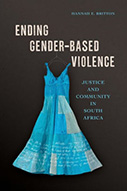Ending Gender-Based Violence: Justice And Community In South Africa

Author: Hannah Britton
Publisher: Champaign, IL: University of Illinois Press, 2020. 232p.
Reviewer: Priscilla Daniels | September 2020
This book is a welcome addition to the South African literature on gender violence. Since seemingly all research on the human condition has been taken over by the Covid 19 pandemic, this of necessity requires Covid 19 to be placed centrally in any future interventions into human problems. More than 200,000 calls were received by the South African (S.A.) national helpline for abused women and children in the first three weeks of the Covid 19 lockdown, which is double the usual volume of calls. Other countries have also experienced increases in gender-based violence (GBV): e.g., Argentina, Cyprus, Northern Ireland, Singapore, Kosovo and France. This book predates the Covid 19 pandemic, and thus its recommendations have to be considered in that context. Nonetheless, it provides an in-depth coverage of the relevant South African studies, and elaborates on their findings in a nuanced manner. Through numerous interviews, the author sheds light on the direct experiences of social workers, volunteers, police persons, activists, et. al., as they confront GBV. The interview descriptions are fascinating, but the content of the interviews with the police officers was especially surprising. They are typically presented as paragons of virtue whose communities are very lucky to have them. But here, the endemic corruption in the police is definitively delineated. While the universality of police corruption in South Africa is acknowledged by the author, it is nevertheless surprising that she accepts the accounts of the officers she interviewed at face value. During the Covid 19 lockdown it is again apparent that given the opportunity that the lockdown regulations gave the police, they acted with extreme brutality towards the citizenry when those regulations were contravened.
The author’s assertion that S.A. has given up on dealing with the broad structural violence which underpins GBV should be treated with caution. The S.A. Domestic Violence Act is a far-reaching structural intervention with both carceral and protective aspects. The virulent corruption at the highest levels of government makes it virtually impossible to establish a culture of valuing non-violence. Given the circumstances, the carceral approach arguably offers the best option for protecting against GBV. It is, however, necessary to improve this law’s implementation and to shine a light on generalised violence that has become the currency of daily interactions in SA.
A central thesis of this book is that gender violence in South Africa is not an isolated event, but rather requires the contextualisation that is elaborated in the book. This is a standard position in GBV research in South Africa, and is not misconceived to my knowledge. The anecdotal reports that the S.A. festive season is also the rape season requires further investigation beyond just anecdotal reports, as is the suggestion that xenophobic rape is common in South Africa. The author appropriately cautions gender violence workers about the roles of traditional leaders and healers. Faith communities are, however, appropriately presented as providing significant resources for gender violence survivors. The author’s recommendations are well considered, but while enormous resources are being drained combating the corona virus it is unlikely that gender violence would achieve any priority status — particularly since it did not have any priority before the pandemic. The author makes the point that place, space, race and community are linked to poverty, and in turn determine the available resources linked to GBV.
The author notes that SA policy is rigorous and progressive, but that structural conditions militate against effective GBV interventions. One could also argue that while the S.A. Government presents GBV as a top priority and regularly makes impassioned pronouncements about GBV, this is clearly more talk than action. Recently, murders and rapes of girls by parolees who had previously committed similar offenses has caused an uproar. The head of the parole system refused, however, to acknowledge that the parole system requires urgent change. Such breaches point to the urgent need to intervene in the carceral aspects related to GBV, while the larger structural aspects are less likely to be implemented. The author contends that underfunding is a key barrier to appropriate interventions for GBV, and such funding is indeed absent, even while President Ramaphosa regularly announces how seriously he considers GBV.
While acknowledging the essential role of the legal and prosecutorial systems in dealing with GBV, the author laments the absence of interventions which address structural violence, inequality and vulnerability. This is not a uniquely South African problem. A well-resourced country like the United States has seemingly also been unequal to the task of solving the problems of structural violence and police brutality as attested to by the Black Lives Matter protests sweeping the U.S. One could argue that even when funds are available, they are not applied to these problems or to the mass incarceration of U.S. citizens. Given the impact of the Covid 19 pandemic in S.A., the structural issues underpinning GBV are more likely to be exacerbated rather than ameliorated.
Prof. Priscilla Daniels, Director: Community Engagement Unit, Office of the Deputy Vice Chancellor Academic, University of the Western Cape


